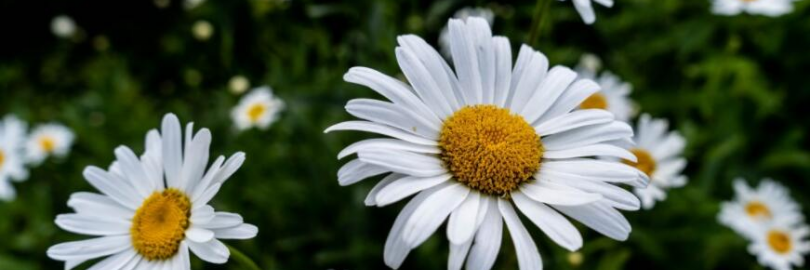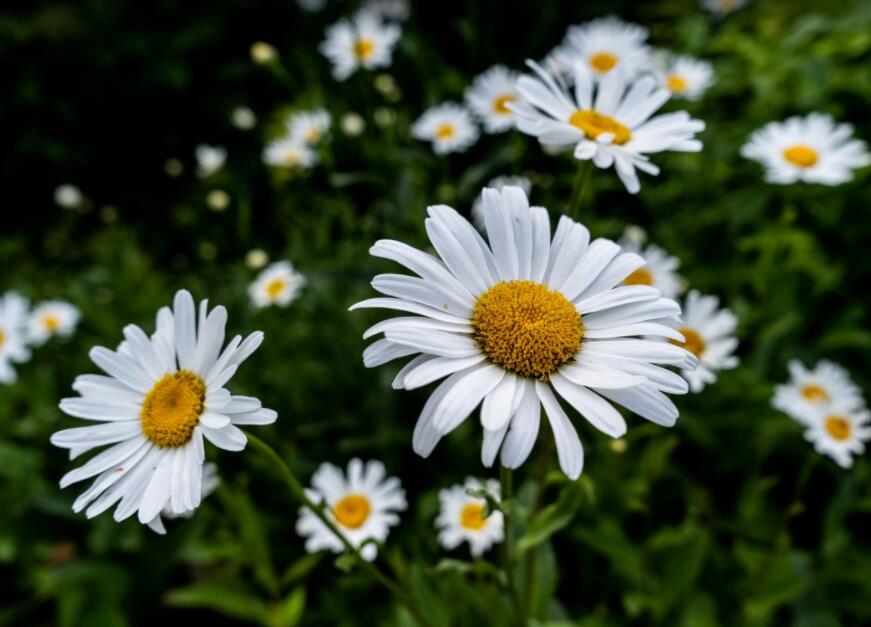
How to Care for Daisy Flowers | Planting, Growing & Caring Tips (22% Cashback)
Daisy Plant Overview
The daisy belongs to the Asteraceae family. With over 1,500 genera and 23,000 species, it is the largest family of flowering plants. Flowers belonging to the daisy family are characterized by a single flower head composed of many tiny flowers (sometimes over a hundred) called florets, which are surrounded by rays of longer petals. In fact, the daisy belongs to the Asteraceae family, along with sunflowers, chrysanthemums, and even lettuce.
Certain types of daisies, depending on the USDA hardiness zone, are perennial plants that return year after year. They are easy to care for and add beautiful bursts of cheery color to your garden or landscaping. Daisies also attract butterflies and look wonderful as cut flowers for vases or bouquets.

Types of Daisy
Perennials
Perennial daisies grow for years at a time, though they only bloom for short seasons.
Annuals
Annual daises go through a complete growth cycle and die in one year. They tend to have long-lasting blooms.
Individual Daisies
Many daisies are stand-alone flowers. You can plant their individual seeds in a flower bed to add color to a garden without having to grow a large shrub. It's hardy to USDA zones 3 through 9.
Daisy Bushes
Some daisies grow on shrubs - a smart choice if you prefer large plants and extra color from foliage.

Common Varieties of Daisies
With its classic yellow center and long white petals, the English daisy is also referred to as the common daisy. With its origins in Northern Europe, this hardy perennial has been distributed widely around the world. In the United States, it has unfortunately become a common weed. However, there are many other varieties of daisies bred from the English daisy that has a much better reputation and can be found in the Bellis genus. Bellis Perennis, also known as the English Common Daisy, this one has full blooms that are usually white or pink and a center that is the same color and protrudes slightly. It is eye-catching and can complement whatever is already in your garden.

If you like online shopping , don't forget to sign up at Extrabux.com!(What is Extrabux) , then you can enjoy up to 30% cashback on your order from Extrabux! Sign-Up Bonus: Free to join it & get $20 welcome bonus!
The Shasta daisy is what most people consider to be the poster child for the perfect daisy - pure white. They are similar to the familiar meadow daisy, but have larger and more abundant blooms. Shasta daisies are a hybrid produced in 1890 and have become a favorite garden plant and ground cover. They are a good choice for high altitude, rain-challenged locations. They're easy to grow and hard to kill. Today's Shasta daisy cultivars offer that and more, with larger, longer-blooming flowers available in single, double, quilled, and fringed forms, some even having yellow petals.

Painted Daisies are native to southwestern Asia, but have become popular in North American gardens for the protection they lend to other plants. They can attract butterflies. Its fern-like leaves make it an attractive plant even after the flowers have bloomed. They are also quite effective at repelling pesky insects and are virtually disease-free. These bouquet favorites bloom from late spring to mid-summer in bushy clumps, growing one to three feet tall. The Painted daisy comes in a variety of bright colors including, white, red, purple, and pink and which are all part of the Chrysanthemum genus. Plant in well-drained soil in full sun to shade, in an area that is neither too hot nor too humid.

Known as the Black-Eyed Susan, this daisy is a hardy American wildflower and can be recognized for its signature yellow or gold petals and dark centers.Gloriosa Daisy is a deer-resistant variety that adds rich, gorgeous color to the summer and fall garden. Black-Eyed Susans typically grow between two and three feet tall. They like to be in the sunlight and can handle a forgetful owner since they're used to growing in droughts. While you do not need to water or fertilize Gloriosa plants, a little extra love and care result in more and bigger blooms. Keep plants well weeded when young.

Gerbera Daisies are some of the most popular cut flowers sold by florists, only behind roses and carnations. Available in a large variety of bright colors and showy flower heads, these daisies have become widely cultivated. These big showy blooms are attractive to both bees and butterflies, but vulnerable to deer, so a fence may be required to keep your gerberas alive. While they are a little tricky to grow - needing lots of direct sunlight but disliking hot temperatures - they are pretty durable during the winter months. The Gerber daisy was originally a tropical plant, but now there are many hybrid versions of the Gerber that can survive in many additional kinds of environments. Gerbera daisies are considered to be perennials in U.S. Department of Agriculture plant hardiness zones 8 through 10, tender perennials in zone 7 and annuals in lower zones.

How to Care for a Daisy Plant?
Planting Season
Plant transplants or direct sow seeds in early spring when there is no more risk of frost. To start daisies indoors, plant the seeds 6-8 weeks before the last frost.
Where to plant
Decide whether you will start seeds indoors, outdoors, or buy transplants. Start the seeds indoors or purchase transplants if you want blooms the same year. If you choose to plant the seeds directly in the ground, expect the plants to bloom in their second year. Use all-purpose fertilizer like 10-10-10 in the amount listed on the label. For the best results, switch to a fertilizer high in phosphorous (such as 10-16-10) just before the plant blooms.
Sunlight
Daisies need as much sunlight as possible, especially in cooler climates. Most species require at least 6 hours of direct sunlight a day during the summer to live. In hot, dry climates, daisies benefit from light shade in the afternoon when the sun is the most intense.
Water
Water daisies when the soil is dry, not on a set schedule. Bone-dry soil results in wilting, and soggy soil creates conditions for disease. Let the soil dry slightly between waterings, which allows air to circulate around the roots. As a general rule of thumb, daisies usually require approximately 1 to 2 inches of water per week during the summer, either through irrigation, normal rainfall, or a combination of both.
Soil
Daisies like rich, fast draining soil, ample water and plenty of sunshine. However, they are very adaptable and will tolerate poor soil conditions and partial shade. Work some well-aged animal manure or organic compost into the soil to help promote abundant blooms.
Fertilizing
Add a general purpose fertilizer early in the growth stage, or about two weeks after the seeds have germinated. At the beginning of every spring season add more mulch and fertilizer.
Pruning
Removing spent flowers (called "deadheading") encourages re-blooming and helps the plant look neater. Even in types that don't re-bloom, snipping off old flowers improves the plant's vigor. Regularly cutting and dead heading is what keeps them blooming.
If you want to find more deals on Daisy plants, you can visit DH Gate; Burpee Gardening; edenbrothers.com; walmart.com with up to 22% cash back from Extrabux!

Extrabux is an international cashback shopping site, offering up to 30% cashback from 10,000+ Stores!
B&H Photo Video, Dyson, Woodland Direct, Ooni UK, Bed Bath and Beyond, TUSHY, Zoro, Anthropologie, 4seating.com, GDF Studio, simplehuman, Appliance Parts Pros, etc.
Join to get $20 welcome bonus now! (How does Welcome Bonus work?)
Recommendation
-

Apple Watch Ultra 2 Real vs. Fake Guide 2025: How To Tell Original From Fake?
-

Microsoft 365 A1 vs. A3 vs. A5: Full Comparison & Verdict 2025
-

Is Turkish Airlines Good for International Flights?
-

Top & Best 12 Sneaker Apps/Websites for Raffles, Releases & Restocks in 2025
-

7 Best Gift Card Exchange Sites - Buy, Sell and Trade Discount Gift Card Safely and Instanly!










